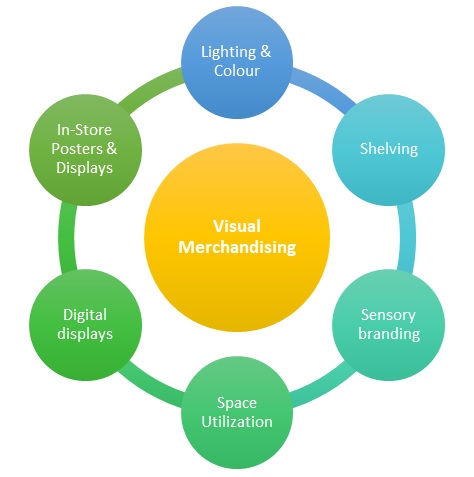- Business Concepts ›
- Marketing and Strategy ›
- Visual Merchandising
Visual Merchandising
Definition & Importance
This article covers meaning & overview of Visual Merchandising from marketing perspective.
What is meant by Visual Merchandising?
Visual merchandising is the process of designing retail floor plans and attractive in-store displays in order to catch the attention of buyers. Visual merchandising is used for displaying goods or merchandise most effectively in stores to boost sales. Visual merchandising uses elements like colors, product journeys, lights, posters etc.
Importance of Visual Merchandising
Visual merchandising is an important aspect in marketing and helps sales at the moment of truth. Several marketers advocate the theory of moments of truth. According to them, there are two moments of truth for a consumer. The First Moment of Truth (FMOT) is the one where a consumer sees a product and buys it. The Second Moment of Truth (SMOT) comes when a consumer actually uses the product or merchandise. Visual merchandising aims at capturing the FMOT so as to persuade a buyer into buying a particular product. In low involvement products like confectionaries, placement of products in a store and their visibility plays a huge part in their sales.

Read More
Key Elements of Visual Merchandising
The products or services are displayed in such a manner so that their features gets highlighted. Several elements of visual merchandising are as follows:
1. Lighting & Colour
2. Shelving
3. Sensory branding
4. Space Utilization
5. Digital displays
6. In-store merchandising such as posters, stand-outs, brand stands, windows etc.
All the above elements of visual merchandising help companies sell the products at the moment of truth, and sometimes also helps in impulse buying.
Hence, this concludes the definition of Visual Merchandising along with its overview.
This article has been researched & authored by the Business Concepts Team which comprises of MBA students, management professionals, and industry experts. It has been reviewed & published by the MBA Skool Team. The content on MBA Skool has been created for educational & academic purpose only.
Browse the definition and meaning of more similar terms. The Management Dictionary covers over 1800 business concepts from 5 categories.
Continue Reading:
What is MBA Skool?About Us
MBA Skool is a Knowledge Resource for Management Students, Aspirants & Professionals.
Business Courses
Quizzes & Skills
Quizzes test your expertise in business and Skill tests evaluate your management traits
Related Content
All Business Sections
Write for Us